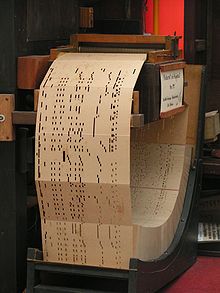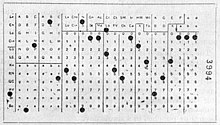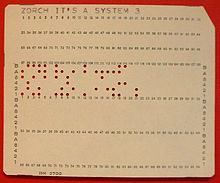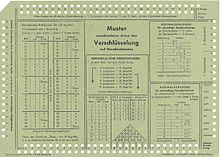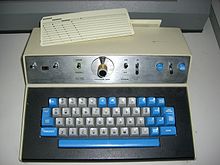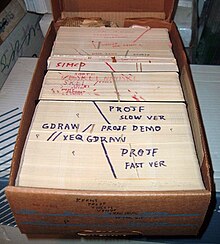Punch card
| Storage medium Punch card
|
|
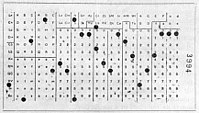 Hollerith punch card |
|
| General | |
|---|---|
| Type | mechanical storage medium |
| size | different sizes e.g. B. Hollerith punch card: 187mm x 83mm x 0.17mm cardboard |
| origin | |
| Launch | 19th century |
| successor | Floppy disk , magnetic tape |
A punch card (LK) is made of mostly high-quality cardboard manufactured disk , which used mainly in data processing for storing data and programs used. The data content was mapped in it using a hole code that was generated and read out with the help of electro-mechanical devices. This technique is generally considered to be out of date.
history
overview
In the early days of electronic data processing, many computer systems could only be fed their input data via punch cards (or punched strips ). Punch cards were also initially used to store inventory data (e.g. bank account information) until storage and processing on magnetic data carriers became more efficient and cheaper. In software development , the program source code was recorded by the programmers on punch cards, processed by translators and also archived as punch cards. Punch cards were also used to load programs (in the machine code , sometimes also as program source text ).
As early as the 1960s, punch cards were gradually replaced by electronic storage media such as magnetic tapes and magnetic disks ; for data collection "modern" were media such. B. floppy disks are used and screen-based acquisition methods with remote data transmission are used.
For a long time, punch cards were used as a carrier medium for JCL control instructions , via which jobs were already carried out using electronic program libraries.
origin

Punch cards Similar systems were from about the middle of the 18th century in the field of automation used. They were mostly used to efficiently repeat recurring processes. Among other things , punched card- controlled looms were built, whereby the first punched cards here were wooden plates. The jacquard loom , which was controlled with perforated cardboard cards in 1805, is known as a further development . Barrel organs are often still today controlled with storage media similar to punched cards (so-called folding cardboard notes or perforated tape rolls), but other automatic and semi-automatic musical instruments also use this method. Charles Babbage planned a punch card control for the design of his analytical engine around 1837 .
The origins of the punch card can be traced back to the way music boxes and other machines work, in which a rotating cylinder or disk with spring-loaded pins or holes attached to it enabled the automated playback of pieces of music and the control of mechanical processes. The basic principle of these punch cards was that the functions of a machine are controlled correctly in a certain way (by a certain code ) and at the correct time. For example, holes are punched into a storage medium made of thin cardboard , the meaning of which is defined in the code used depending on the position. To execute the coded functions, the holes in the storage medium are scanned by a 'reading unit', decoded by a suitable device and thus assigned to the respective function.
Before the development of electronic data processing, the representation, storage and processing of data in the form of perforations in a medium made of paper, cardboard or the like enabled the most economical way to quickly and easily duplicate coded data , in contrast to systems such as the pen roller Means to write a new code. Early data processing and registration systems were inconceivable without punch cards.
Hollerith punch card
The punch card, which was later widely used in the computer sector, goes back to the US American census in 1890, for which Herman Hollerith developed a method based on punch cards, including the associated punching and evaluation machines ( tabulating machines ). The punch card was no longer functionally controlling, but used as a carrier of factual data. The census was conducted between June 1, 1890 and July 1, 1890. The data for the population registration were entered manually directly into the tabulating machines. The results of this data were published on December 12, 1890. All other data were first punched into the punch cards and then evaluated with the tabulating machines. The first part of the results was on 12 December 1892 as the Compendium of the Eleventh Census Part I published. Parts 2 and 3 were published in 1894 and 1896, respectively.
After its mass premiere, the census, the punch card was mainly used in mechanical and electromechanical calculation and punch card sorters and punch card mixers. However, it was not until 1928 that the punch card got its final, standardized format. After its inventor, the name Hollerith card was also common for this type of punch card .
A Hollerith punch card - in the form that was most common for the wedding of the punch card - is a rectangular piece of 0.17 mm thin cardboard of high paper quality with a uniform thickness (161 g / m²), in which holes are punched column by column in predetermined positions with the help of a special punching device in order to encode a sequence of characters . The coding was initially symbolic, i.e. its meaning was agreed for each hole (e.g. hair color or religion, etc.). Only later punch cards contained coded numbers, and even later alphanumeric data such as letters and special characters.
When digital computers were developed in the 20th century , the already established punch cards offered themselves as a medium for entering programs and storing data. Such a Hollerith punch card is i. A. printed on the front at the hole positions, the top left corner is approx. 1 cm high and bevelled flat to enable manual orientation front / back or bottom / top; the other three corners are rounded or square (see pictures). In the specified positions, holes were usually punched column by column with the help of a keyboard-supported punch card punch in order to encode the desired content in the punch card . For better readability by people, in addition to the perforation area (only this “interested” computer), the recorded content was printed on the upper edge of the card, usually with the exact columns of the perforations.
The usual maximum line length of almost 80 characters in e-mails and text files goes back to this punched card format , as does the JCL format of IBM mainframes and the display format of mostly 80 characters width of terminals or terminal emulations , which u. a. when data acquisition devices / systems later replaced punch cards.
Holes can be punched in 80 columns and 12 lines in the punch card. Originally, only one hole was allowed per column, which meant one digit. Later a second hole was allowed, which was then described in capital letters; a third hole added special characters. With the use of the EBCDIC code since 1964, up to 6 holes were defined (this made 256 different characters possible). A card corresponds to a line of text and a column of the card corresponds to a character position in the line. A punch card thus had a capacity of 80 bytes .
For comparison: The contents of a million punch cards so as filled a 80- MB - HDD , a standard in the 1970 order on mainframes. As a single stack of cards, this would make up 170 meters, roughly the height of the Ulm Minster , the dry weight is around 2,500 kg, not including the around 100 kg packaging.
In 1966, Karl Ganzhorn and Wolfgang Walter describe the special properties of punch cards as follows. Quote: “Your main advantages, like
- machine and visual readability
- mechanical duplication, mixing and sorting,
- the outstandingly good signal-to-noise ratio (> 10 6 ),
- low cost
- universal suitability for machine data input and output,
have not yet been achieved by any other storage medium in this ideal combination. "
Numerous improvements to the punch card systems go back to Gustav Tauschek (1899–1945).
End of the punch card era
From the mid-1960s, magnetic tapes began to spread as a medium for storing and sorting data in data centers. They were faster and had a much higher capacity in terms of volume and weight. In the mid-1970s, the punch card was largely out of use and also replaced for data acquisition from magnetic tape cassettes and / or diskettes .
Another story
In individual cases, punch cards were and are used much later and for different purposes.
Votomat
Punch cards are used in US voting machines . In the election of George W. Bush as President of the USA , ballot papers were sometimes used that were punched by hand with a pen like punch cards by the voters. In the USA 2000 presidential election, punch cards in Hollerith format were also used. In Florida there were glitches with the vote count; the voting system using punched cards came under fire. It was therefore decided, starting with the 2004 presidential elections, to abolish punched cards in this area too and to replace them with electronic voting systems. In the US presidential election in 2004, punch cards were still used in some cases.
"The vast majority of US citizens will continue to do it in the conventional way: either with a cross, by writing down the name of the preferred candidate, by marking boxes next to the candidate's name - or by punching holes."
Even in the 2012 US presidential election, the changeover was not yet complete.
Time clock
Punch cards in Hollerith format are still used today with some mechanical time clocks . Real punch cards are no longer important in computer technology these days. However, survey data are still often saved in files whose format is based on punched cards - even in the 21st century there are still "columns" and "cards", even if only virtual (see: List of terms and methods in market research ).
discotheque
In some discos and similar gastronomic establishments, punch cards are still used today (in 2018) to account for consumption. At the entrance, guests receive an unpunched punch card with fields with different amounts of money printed on them in a matrix. When an order is placed, the operator uses special pliers to punch out the fields that represent the value of the order. Each pair of pliers has its own hole pattern, so that you can later determine who took the order. At the exit, the cards are read in a card reader and the total is calculated. According to the terms and conditions , the maximum possible sum will be charged if the card is lost.
Parking ticket
Another example is a department store parking ticket . The car park pay machine recognizes from the perforation that the customer tariff is to be applied.
Program punch cards
Some programming languages and data formats , the origins of which date back to when punch cards were a common storage medium, still know the corresponding formatting today (after 2000), especially for program source texts. The fixed alignment to the columns of the punched cards had an effect on the syntax of some programming languages.
Example Fortran
In the old Fortran variants, the first five columns were intended for a numeric label . A quick review of the punch cards made it very easy to identify if a label or the source code was incorrectly positioned. Any character in column 6, usually an asterisk or a capital C (for continue), meant: continuation card, i.e. H. the instruction on the previous punch card / line continues from column 7. Fortran reserved the eight columns 73 to 80 for comments. Here it was common - and supported semi-automatically by the later programmable card holes - to punch a consecutive number so that a pile of punched cards that had fallen down could be sorted more easily. These areas were clearly marked visually on punched cards produced for Fortran programs.
The programming language COBOL with its language syntax is also based on the punch card; The RPG programming language also offers structures adapted to punch card formats. In general, other data cards also normally had a fixed format, with a data record corresponding to a card and where the input data such as amount, customer number and date were assigned to fixed areas of the columns.
Designation "Batch"
The English name for a deck of cards is batch . At the time when electronic storage media (such as magnetic disks) were not yet generally used, the control instructions for the programs, including their input data, and sometimes the program code itself, were available in the form of stacks of punched cards. Since the manufacturing process also job was called, it emerged the terms batch job, batch file and the file extension .bat for DOS - file . From the pictorial representation of the data to be processed as a batch, the term batch processing also arose , in which the input data, which were later no longer punched cards, are processed one after the other.
Punch card formats in data processing
The first format
On September 23, 1884, Herman Hollerith filed his first patent application on the subject of "Art of Compiling Statistics". In the following years he experimented with different punch card formats and arrangements. In 1886 cards were used in Baltimore that "... had three rows of holes on each of the two long sides with a total of 192 hole positions". The punch was punched with a punch .
1890 census
Hollerith registered the following format with the patent in 1887:
3 1/4 inches high, 6 5/8 long ... this card offers 288 hole positions: 24 hole columns with 12 punch card positions each. The holes were round; the 8.3 × 16.8 cm map already had the characteristic corner section (in contrast to the quasi-norm that was later enforced, however, it was still at the bottom right) and was printed with numbers and lines.
40 columns
Pictured on the right is a punch card with 40 columns, used for a commercial application.
45 columns
However, the map has been expanded to 45 columns with 12 positions each. This corresponded to 45 characters with 12 possible hole positions in the coding typical for punch cards. A binary coding which interprets the holes as bits was not used initially. A 6-bit coding was only used later, which allowed 2 characters per column (from a character set of 64 characters), i.e. a total of 90 characters to be stored on the card.
60 columns
In the 1933 census conducted by DEHOMAG in Germany, punch cards with 60 columns were used.
80 columns

IBM patented an 80-column format with rectangular holes in 1928, which was widely used until the 1970s.
96 columns (IBM)
With the introduction of the IBM System / 3 in the mid-1970s, IBM created a new punch card format with 96 columns. These cards were about a third narrower than the 80-column cards and had circular holes with a diameter of 1 mm.
The data was saved in:
- in the six-bit code BCD (binary-coded decimal values), in three rows with 32 characters each
- alternatively in the 8-bit code EBCDIC . The two uppermost data areas were assigned 6 bits each; in the lowest area, the 2 missing bits were added to form areas 1 and 2 in the appropriate column; the card could only hold 2 × 32 = 64 characters in this mode.
In contrast to the Hollerith-based punch cards - with numerical perforations from 0 to 9 - the data was stored in a binary format, the 'value' of each character results from the combination / addition of the 6 plus 2 bits set.
Special punch card formats
Hand punch cards
"Hand punch cards" were called punch cards that were processed and evaluated manually or with simple tools (pliers, drills, needles), not machines (computers); they are closer to index cards than to machine-processed punch cards. Different types became known:
- Edge punched cards had rows of holes on the four side edges of the index card.
- In the case of slot- hole cards, the area with the perforations was in the card surface. Two holes were connected to form a slot for coding.
- Visual punch cards were index cards to issue cards. Each eye card represented a feature. The numbers corresponding to the perforations indicated which index card or document the feature was assigned to. When placed one on top of the other, several viewing hole cards resulted in an AND link at the translucent points. Punch cards were u. a. used by the GDR Ministry for State Security (MfS) from 1980.
Edge punch card
Until the 1990s, there were so-called edge hole cards - sometimes also referred to as notch hole cards - that were processed manually. Various search criteria (for example in libraries) have been coded with holes or slits on all four edges of the card. For a long time, this procedure ensured efficient administration of index cards for archives and libraries without the use of computer technology, which was expensive at the time.
These cards all had the same arrangement of holes on the edge in the uncoded state. By removing the material between the hole and the edge of the card, a slot was created, the coding. If you now had several cards with different coding, you could sort the cards with the help of a needle that fit through the holes.
First you put the unsorted cards together as a stack (so that you could see that they were all with the right side in one direction, the upper right corner of all cards was beveled). Then you could put one or more needles through the desired holes (search criterion). By lifting the needles, only the cards that had intact holes in these positions were also lifted . If there were slots in these places, these cards fell out of the bottom of the pile.
For the encryption of the coding of the edge punched cards there were "overlayable" and "non-overlayable" keys. This sample card was included with the purchase of a set of «slotted edge hole cards» (see picture on the right). The combination of viewing punch cards with edge punch card encryption was interesting.
Film punch card
The film punch card according to DIN 19053 has a 35 mm microfilm glued into it. It is used, among other things, to archive drawings, with the punch card adding metadata to the drawing that can be sorted by machine. Due to the longevity of microfilm and the robustness of the punch card, this archiving method is still in use, but mostly as a backup for a digitized archive.
Keyhole card
Small punch cards are still sometimes used as key cards in hotels .
Other punch card applications
Because of their robustness, punch card systems were also used in other areas of application, for example as a program carrier for washing machines, for key cards and ID cards, as well as in elementary school with the Profax learning device. In some cases, the punch cards were welded into transparent or translucent plastic. In the meantime, these punch cards have also been largely replaced by chip cards and similar systems.
Working method
Creation of punch cards
In order to create punched cards, there were punched card punches which, manually operated, punched holes in columns in the card so that they represented a different defined character depending on the vertical hole position and combination. Newer devices printed in addition to the punched code - in order to make the card readable for humans - the content as plain text on the upper edge of the cards. Experienced programmers were able to interpret the information without tools, simply by looking at the hole positions.
These devices had a typewriter keyboard (mostly with a numerical block keyboard ), a feed device for empty and a storage device for punched cards and - to control and accelerate the recording processes - a so-called program card . This was z. B. stretched on a rotating drum, which was scanned by electrical sensors and controlled certain functions depending on the content of the card. So could z. B. Fields (column areas) can be defined as numeric or alphanumeric. Certain fields could be jumped to or skipped over directly, so that only certain field contents had to be typed in without pressing control buttons. Other program instructions caused certain column areas to be copied from a previous card to the new card.
There was a copy button on the keyboard with which the card just punched could be copied to a desired column. This function was later taken over by operating systems with terminal-controlled input in order to output an edited line on a teletype or later on the monitor. The last line entered can still be used today. B. at the Windows command prompt can be copied character by character with the right cursor key and the whole with the up cursor key.
Optionally , the data could be re-entered for control on a second machine, the punch card tester. If the holes matched, the card was marked as checked, otherwise it had to be corrected.
In rare cases, hand punches were used with which, if necessary, after pasting over faulty holes, certain columns could be punched again or whole cards could be recreated.
Processing of punch cards
The punch cards were read in by the punch card reader , a peripheral device of the computer. The stack of punched cards was placed in a reading slot and - for better mechanical feeding - weighted down. The beveled upper left corner of the punched cards ensured that the operator was using the device correctly. The reading process was started at the push of a button. With a fan and rollers, the pile was loosened up directly in front of the card feeder and one card after the other was read. The reading process was carried out either by mechanical scanning with pens, by brushing - with the punch card serving as an insulator for the contact roller - or by light barriers with photocells .
The programs of that time were not interactive: A program was started, read input data of a certain classification term, processed it and outputted result data - again as punch cards and / or via printer. The program controlled the card reader, the punch card punch and the printer as peripheral devices of the central unit .
This way of working required different 'sets' (stacks) of punched cards: For example, a punched card set contained the processing program (e.g. in the machine code ) that was loaded into the working memory at the start of work. Other punch cards contained technical control instructions for processing (“job cards” for JCL ). Other stacks of punched cards (one or more) provided sorted input data. Insofar as result data were to be output as a database (depending on the program, lists / reports generated via a printer were often sufficient ), this was another stock of punched cards - the i. d. As a rule, it was used again as input on the next processing date.
Processing with other punch card devices
- Punch card labeler, also known as “punch translator”: Since not all punchers were able to label the cards with plain text, separate devices were sometimes used for this, which read punch cards automatically, scanned the code and added the lettering later, e.g. B. at the top of the map. Card punchers could also be used for this function. The labeling was only necessary if the punch cards had to be edited by people, e.g. B. Program code punch cards by programmers.
- Punch card sorter - for the electro-mechanical sorting of punch cards before processing
- Punch card mixer - for mixing punch cards from different stacks of cards, e.g. B. Transaction data behind master data. For this purpose, the punch cards usually contained a 'card type' in the foremost columns - which was also used in the processing of data recognition. The mixer could also be used to separate batches of data (e.g. after processing).
- It was also possible to use the line editors with punch cards, which were also introduced with the introduction of the first line terminals. B. to change saved programs.
transport
Punch cards were mostly not processed where they were created (e.g. in the “punch room”), but mostly in a data center . They were also stored / archived elsewhere. Therefore, they had to be physically transported several times between different locations / locations.
- Transport for processing: Often there were relatively long transport routes and long transport times. In order to transport the punched cards reliably and punctually to the data center, companies and corporate groups, public bodies, universities and even the military sometimes operated courier services in pre-war times , which transported the punched cards to the place of processing to the processing dates, possibly including the processing results such as Returned account statements, invoices, lists, etc. the next day.
- In software development : If the source code of programs was stored on punched cards, the programmers had to manually incorporate changed, new and removed cards into the stack of cards stored in a program card archive in the event of program changes, and deliver the entire program to the data center for compilation. Larger programs could e.g. B. consist of 5,000 to 8,000 cards, i.e. approx. 4 boxes each weighing approx. 2-3 kg.
- In the data center: The punch cards were picked up from the delivery stations, checked and supplemented in work preparation and brought to the machine room. There they were processed on the planned date and returned to the archives or to the consignor via result boxes.
The punched cards were generally transported in plastic containers in which the punched cards were fixed with clamping strips if they were not completely filled. In part, e.g. B. inside a building, the cardboard boxes were used in which the punch cards were supplied by the manufacturer, 2000 pieces per box. Transport trolleys were used inside buildings for larger amounts of data. To optimize the transport (volume / weight and time), partially and as a temporary solution, punch card content was transferred to electronic media, which was then transported or the data was sent via remote data transmission .
Storage and archiving
Working with punch cards also required space to store them. Often there were separate areas:
- Blank card area (mostly near the punching stations): This is where blank (“neutral”) cards and - for better readability by the processor - cards with the individual card fields printed on. Larger warehouses were certainly in the cubic meter range or filled entire rooms.
- Short-term area for punch cards that are due to be processed soon, sorted according to the various suppliers, applications, etc.
- Inventory data from completed processing, required for subsequent processing; sorted by stock types
- Input data after processing - for further processing, e.g. B. monthly processing, interest calculation, etc.
- Input data after the last processing - for data backup
- Source code archives and also card stocks with machine code (as long as there were no electronic program libraries)
- Recycling stocks after the data backup period has expired - until collection for recycling , sometimes also for storage for antiquarian reasons
All of these archives were filled manually or stacks of cards were manually removed from them for processing. The punch cards "should be stored in an air-conditioned archive so that they have the same humidity as the air in the IT room".
Punch card coding
The data content of punched cards is represented by perforations. Which character is displayed results from the position of the perforations (possibly with multiple perforations per column) - the combinations of which are defined / agreed in a code system. Over the relatively long period of use of punched cards, different code systems were in use, depending on the type of punched card and the manufacturer of the punched card processing equipment.
In addition to the best-known 80-character system from IBM, z. For example, a 45x2 line system (= 90 characters) from Remington Rand and a format with 96 columns and 24 lines presented later by IBM for the System / 3 are in use.
Example: IBM 80-character code:
These punch cards, u. a. Used on 360 Series systems, had 80 columns that could accommodate 1 character each. Its value / content was determined by perforations in the 12 lines arranged vertically one above the other: For integer values from 0 to 9, only the lower 10 hole positions were used as an alternative. In the top two lines (also called "zones" or "zoning"; '12er' and '11er' zone), minus values were identified by so-called "over-holes" or the character was a letter or special character. The third line from the top was the zero row of the numerical part; it was also used as over-punching for multiple perforations and was designated as the '10' zone.
The following perforations were used for the characters or values specified in the punch card code and vice versa (the perforations were interpreted as corresponding characters):
- Numbers 0 through 9 with no sign : hole in one of the numerical lines 0-9
- Numbers 0 to 9 with sign: negative numbers were coded in addition to the holes 0-9 with over-holes in the 11 zone of the last column of digits; In some cases, positive numbers were displayed with 12 holes, but usually without extra holes as a neutral number.
- Alphabet A to I: Zone 12 plus numeric 1 to 9
- Alphabet J to R: zone 11 plus numeric 1 to 9
- Alphabet S to Z: 10s zone plus numeric 2 to 9
- Lower case letters, umlauts and special characters as well as (in a later version of the LK code) all combinations of the EBCDIC code were shown with additional hole combinations, namely with up to 6 holes per column.
One recognizes a certain connection between the punched card coding and the EBCDIC code - in which the punched card contents were stored in the main memory or on electronic data carriers in hexadecimal form: the over-punching went into the first half-byte (the zone part), the numerical punching (at Digits) unchanged in the second nibble (the number part). So was z. B. the letter "A" hexadecimal to "C1", the letter "S" to "E2", the unsigned digit "3" to "F3". "3" was saved as a positive value with "C3" and as a negative value with "D3". For internal processing in arithmetic operations , numeric LK fields had to be converted into internal numeric data formats - for example into the binary or the 'packed' data format. This was programmed individually in assembly languages (e.g. 'PACK ZWI_FELD, LK_FELD'), higher-level programming languages inserted such conversions automatically.
Thus, in a punch card column z. For example, the negative value "−4" is coded with an 11 hole and the 4 in the number part - identical to the letter "M". Whether "M" or "minus 4" was valid depended on whether the processing program interpreted the column as part of a text field or a numeric field (last column).
literature
- Bernd Bode: punch card technology . Springer Fachmedien, 1968, ISBN 978-3-663-03040-9 ( limited preview in Google book search [accessed October 10, 2019]).
- William Aspray (Ed.): Computing before Computer. Iowa State University Press, Ames IA 1990, ISBN 0-8138-0047-1 .
- Geoffrey D. Austrian: Herman Hollerith. Forgotten Giant of Information Processing. Columbia University Press, New York NY 1982, ISBN 0-231-05146-8 .
- Markus Krajewski: Paperwork. The birth of the card index from the spirit of the library (= copyrights; Vol. 4). Kadmos, Berlin 2002, ISBN 978-3-931659-29-5 .
- Paper machines. About Cards & Catalogs, 1548-1929 . Translated by Peter Krapp (= History and Foundations of Information Science). MIT-Press, Cambridge / Mass. 2011, ISBN 978-0-262-01589-9 .
Norms
- DIN 19053: 1991-01 Microfilm card for 35 mm film.
- DIN 66004-2: 1982-09 Information processing; Coding on data carriers; Representation of the 7-bit code and the 8-bit code on punch cards. (identical to ISO 6586: 1980-11)
- DIN 66018 supplement: 1972-05 punch cards for information processing; Storage and handling.
- DIN 66018-1: 1972-05 Punch cards for information processing; Dimensions, requirements, testing.
- DIN 66018-2: 1972-05 Punch cards for information processing; Dimensions and location of rectangular holes.
- DIN 66228-1: 1978-05 small punch cards for information processing; Dimensions, requirements, testing.
- DIN EN 2484: 1989-10 Aerospace; Filming of drawings; Microfilm punch card for film 35 mm; German version EN 2484: 1988.
- ISO 6586: 1980-11 Data processing; Implementation of the ISO 7-bit and 8-bit coded character sets on punched cards - data transmission; Use of ISO 7-bit and 8-bit coded character sets for punch cards. (identical to DIN 66004-2: 1982-09)
- VDA 4903: 1982-04 microfilm; Uniform microfilm punch card for the automotive industry.
Web links
- Historical report on punch card systems in the US Army
- Functional punch card EDP in the museum
- Punch cards in the German Museum of Books and Writing
- Virtual punch card museum
Individual evidence
- ↑ WM Kähler Introduction to the COBOL programming language
- ↑ enzyklo.de Term punch card several sources name LK as out of date
- ↑ cyberport.de technology lexicon … punch cards are now very outdated
- ↑ a b Datenträgermuseum ( Memento from September 10, 2014 in the Internet Archive ) … punch cards as a medium for entering programs…
- ↑ Robotic technology
- ↑ The history of machine data processing, Volume 1: IBM Encyclopedia of Information Processing, IBM Form D 12-0028 (3/91), p. 34
- ^ The historical development of data processing Karl Ganzhorn and Wolfgang Walter, Revised and extended version, 1975 (first published in 1966) IBM-Form F 12-1600-1, p. 50
- ↑ Robotron technology: data carrier / memory , accessed on July 20, 2012
- ↑ Bernhard Engstler: Media Technology Seminar (PDF; 1.3 MB) Retrieved on July 20, 2012
- ↑ Siegesmund von Ilsemann and Stefan Simons: USA: Decision in court? In: Der Spiegel . No. 46 , 2000, pp. 196 ( Online - Nov. 13, 2000 ). with illustration of cards
- ↑ Michael W. Traugott: The American electoral system . Published on the website of the Embassy of the United States of America, accessed July 20, 2012
- ↑ Hasnain Kazim: Das Loch zur Macht , Spiegel Online , article from October 29, 2004, accessed on July 20, 2012
- ↑ "Voting is done by mail or online and - as in some areas in Idaho - sometimes with punched cards.": An election made for lawyers , Zeit Online from November 6, 2012
- ↑ One Point Cash System - punch card. Retrieved June 18, 2018 .
- ↑ Heise online April 12, 2016 "From punch cards to web services: IBM i 7.3"
- ↑ IT-Service24
- ↑ The history of machine data processing, Volume 1: IBM Encyclopedia of Information Processing, IBM Form D 12-0028 (3/91), p. 18
- ↑ The history of machine data processing, Volume 1: IBM Encyclopedia of Information Processing, IBM Form D 12-0028 (3/91), p. 19
- ↑ Edwin Black: IBM and the Holocaust: the entanglement of the global corporation in the crimes of the Nazis . German edition, Propylaen Verlag, Berlin 2001, ISBN 3-549-07130-2 , p. 70.
- ^ Edwin Black: IBM and the Holocaust . German edition, Propylaen Verlag, Berlin 2001, ISBN 3-549-07130-2 , p. 70
- ^ IBM: "IBM card," IBM archive in English
- ↑ IBM product announcement: IBM System / 3 (PDF; 1.7 MB) in English
- ↑ 96 columns punch card code ( Memento from April 15, 2007 in the Internet Archive )
- ↑ 96-column Punched Card Code. Archived from the original on April 15, 2007 ; accessed on November 6, 2012 .
- ↑ Dietmar Strauch, Margarete Rehm: Lexicon Book - Library - New Media, Walter de Gruyter, 2007, ISBN 978-3-598-11757-2 , online: ISBN 978-3-11-092121-2
- ^ Wilhelm Gaus: Theory and Practice of Information Retrieval
- ↑ Service instruction No. 1/80 on the principles of preparation, recording and storage of operationally important information by the operational service units of the MfS
- ↑ ISG saves images and texts on COM. Computerwoche , May 18, 1984, accessed November 25, 2015 .
- ↑ "aperture card combination of punch card and microfiche, mainly in drawing films, sortable" ( secretaries manual. Google Books, extract, accessed on November 4, 2016 . )
- ↑ Technical Center 29
- ↑ M. Koltes German Studies on the Internet ("boxes with punched cards stored in the faculty cellars ")
- ↑ Computerwoche guidelines for the installation planning of the IT room .
- ↑ Knebel Museum IBM
